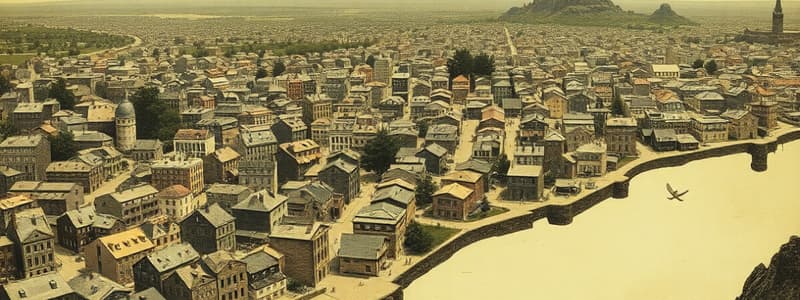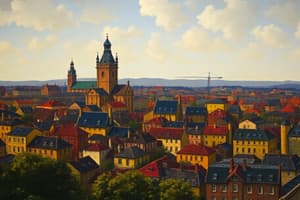Podcast
Questions and Answers
The transition from hunting and gathering to settled farming significantly reduced human populations due to the increased labor demands.
The transition from hunting and gathering to settled farming significantly reduced human populations due to the increased labor demands.
False (B)
The primary factor determining which villages evolved into towns was solely the abundance of local natural resources.
The primary factor determining which villages evolved into towns was solely the abundance of local natural resources.
False (B)
The Industrial Revolution led to decreased urbanization in Europe and the USA due to the decentralization of factories.
The Industrial Revolution led to decreased urbanization in Europe and the USA due to the decentralization of factories.
False (B)
Urbanization only occurs through migration from rural areas, with birth rates having a negligible impact.
Urbanization only occurs through migration from rural areas, with birth rates having a negligible impact.
A megacity is defined as an urban area that has exactly 10 million inhabitants.
A megacity is defined as an urban area that has exactly 10 million inhabitants.
Flashcards
Settlement
Settlement
Settlements are clusters of dwellings where people live together in one place.
Town
Town
A town is a larger settlement that grew from a village, often due to advantages like better location and access.
Industrial Revolution
Industrial Revolution
The Industrial Revolution was a period starting in the 18th century when factories and industry grew rapidly, especially near resources like coal and water.
Urbanization
Urbanization
Signup and view all the flashcards
Megacity
Megacity
Signup and view all the flashcards
Study Notes
- The topic is how cities and towns grew
- Learning outcome: More than half of all humans live in towns or cities, and this study explains how
- Keywords: Farming, Settlements, Town, Industry, Urbanisation, Megacity
Once Upon a Time...
- Ancestors lived by hunting, and eating wild fruit and seeds
- They were always on the move, looking for food
- 12 000 years ago, people began to plant seeds and rear animals
- The first animals they reared were sheep - this was the start of farming
- Farming allowed people to settle in one place
- Over time clusters of dwellings grew to become settlements
How Towns Evolved
- Farmers grew enough extra produce to sell
- Not everyone needed to farm so markets began
- Villages grew around the markets
- Some villages grew into towns because they had advantages, such as being easier to reach from many directions
- The Industrial Revolution began in the 18th Century
- Factories sprang up in or near towns with access to coal, water and other resources
How Cities Evolved
- People from rural areas went to towns hoping to work in the new factories
- Towns grew into cities
- Industry spread to other European countries, and the USA, thus towns and cities also grew
- African and Asian cities are growing fastest today
What is Urbanisation
- Every week, 3 million people move from rural to urban areas across the world
- Many new babies are born in the urban areas
- The percentage of the world's population living in urban areas is increasing, called urbanisation
Urban Areas Are Spreading
- Populations grow, and urban areas spread, absorbing nearby towns and even rural areas
- A city with over 10 million people is called a megacity
- There were 33 megacities in the world in 2019
- Megacities are formed when major cities fuse together
- The biggest megacity is Tokyo, with over 37 million people
Studying That Suits You
Use AI to generate personalized quizzes and flashcards to suit your learning preferences.




